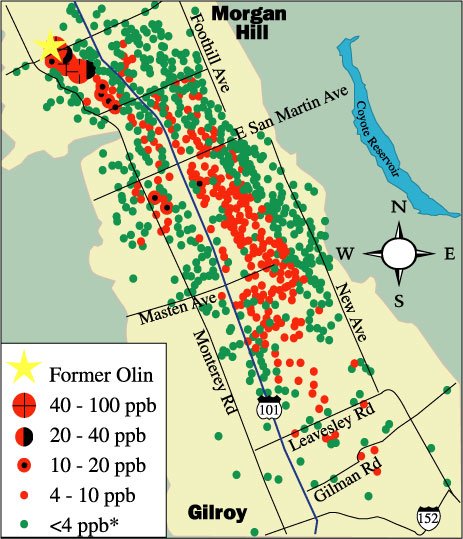GILROY
– City officials will try to ensure Gilroy isn’t engulfed by the
perchlorate plume that has contaminated its neighbors’ groundwater
systems to the north when they meet face-to-face with state-level
water board members Friday.
GILROY – City officials will try to ensure Gilroy isn’t engulfed by the perchlorate plume that has contaminated its neighbors’ groundwater systems to the north when they meet face-to-face with state-level water board members Friday.
City officials will ask the Regional Water Quality Control Board of Directors to impose a number of actions to keep the toxic chemical from spreading into Gilroy’s drinking water supply. Specifically, they want to make the company that contaminated at least 450 South County wells:
• determine the southwestern extent of the plume,
• install a system of wells to help filter perchlorate from Gilroy groundwater before it reaches city drinking water wells,
• fund a contingency plan for the potential loss of the city’s water supply,
• and, do all of these things expediently.
The call for faster decision making is crucial, City Administrator Jay Baksa says, because all of Gilroy’s tap water comes from an eight-well system just south of Leavesley Road near U.S. 101. If perchlorate contaminates these wells, the entire city drinking water supply would be impacted.
“If we lose even one or two of those wells, that’s a large percentage of our water,” Baksa said. “We understand the board has a lot on its plate right now with the contamination at the site (in Morgan Hill). But they have a talented staff with people who are capable of doing more than one thing at a time, and we feel we need some focus placed on our concerns.”
Perchlorate has left Gilroy city wells untouched thus far. However, since late spring perchlorate has been showing up in private wells south of Leavesley Road around Holsclaw Road, less than a mile from some city wells. Also making officials uneasy is that results from city well samples taken in early August have not yet returned from the lab.
“There are a lot of questions that need to be answered, and we don’t know exactly where perchlorate is and isn’t in that area,” said Harvey Packard, an engineer with the Central Coast branch of Regional Water Quality Control. “Gilroy has had concerns for quite a while, but we haven’t talked yet in concrete terms about how things can get fixed.”
Gilroy officials will get the chance to begin this new level of discussion Friday at the Board of Directors meeting. But they’ll have to make the case quickly.
The Regional Water Quality Control Board has allotted roughly 30 minutes for the presentation by Gilroy and representatives of Morgan Hill, San Martin and the Santa Clara Valley Water District. Officials from these agencies met in recent days to coordinate the presentation.
“Each of us have a different set of concerns,” Baksa said. “Our key message will be that identification of the plume needs to happen quickly. We’re in a position to avoid another San Martin situation. Let’s take advantage of that because the window of opportunity is closing.”
Baksa described city staff’s relationship with regional water quality staff as “good,” but said Friday’s session will give the agency’s board of directors a chance to put a face to officials’ names, from city managers to mayors.
In addition to several city and water district staffers, Gilroy Mayor Tom Springer and Morgan Hill Mayor Dennis Kennedy will be attending Friday, as will Sylvia Hamilton, chairman of the San Martin Perchlorate Citizens Advisory Group.
“I think it’s important for us at this point to create a face-to-face situation and build a relationship with the board. I wouldn’t go as far as saying it’s a lobbying effort,” Baksa said.
Whatever it’s called, the content of the presentation figures to be news for the board. Even staffer Packard was unaware of Gilroy’s requests. Nonetheless, Packard said Gilroy’s points of interest sounded “reasonable.”
“What Gilroy is asking for is fairly straightforward and not technically challenging,” Packard said. “It’s all doable. It’s just a matter of where and when and how.”
The most elaborate of Gilroy’s requests is a leaching system similar to what is being proposed at the defunct Morgan Hill factory on Tennant Avenue, the source of the contamination. The leaching system would flush perchlorate from soil and groundwater before it reaches city wells.
The Tennant Avenue factory was contaminated with perchlorate by Olin Corporation which made road flares years ago. Perchlorate, a salt that can impair thyroid function and cause tumors, is used primarily in flares and rocket fuel because it burns efficiently.
Olin has been supplying bottled water to the 450 well owners impacted by the contamination.
Friday’s meeting will be held at Salinas City Hall, 200 Lincoln Ave. in Salinas. The session starts at 8:30 a.m., and the perchlorate cleanup issue is placed toward the beginning of the multi-hour session.














